Blog Archives
Bodhinatha in Vancouver
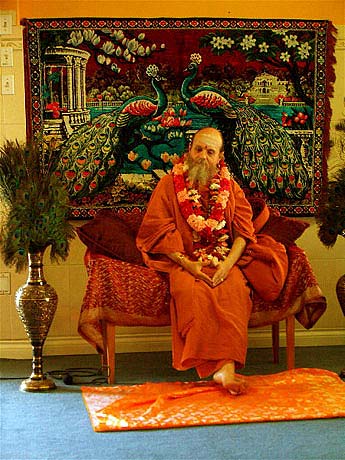
A few more pictures arriving from Bodhinatha’s visit to temples in Vancouver. Here he is waiting as he is being introduced before his talk at the Murugan temple.
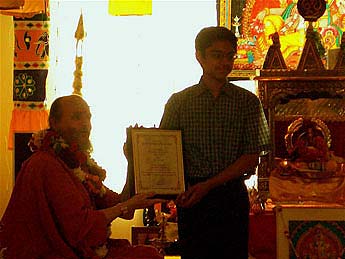
Bodhinatha visiting the Sri Ganesha temple in Vancouver, Canada.
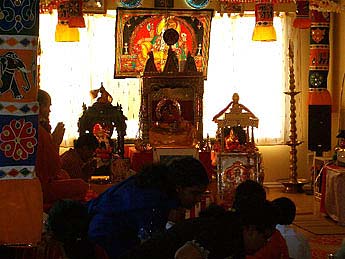
Bodhinatha and devotees at the Sri Ganesha temple in Vancouver, Canada.
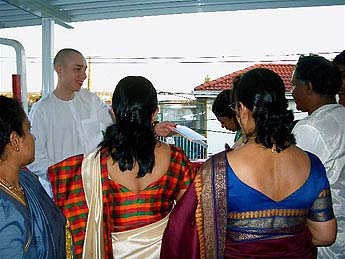
Aubry showing devotees at the Sri Ganesha temple Gurudeva’s books and Hinduism Today magazines.
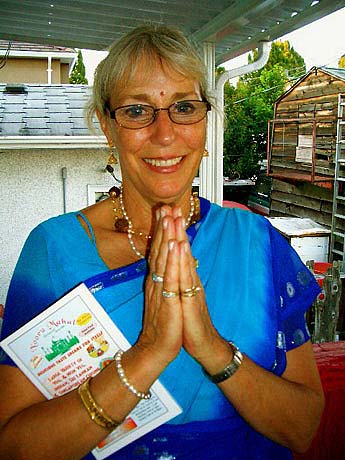
Devi Tandavan enjoying Bodhinatha’s visit to Vancouver.
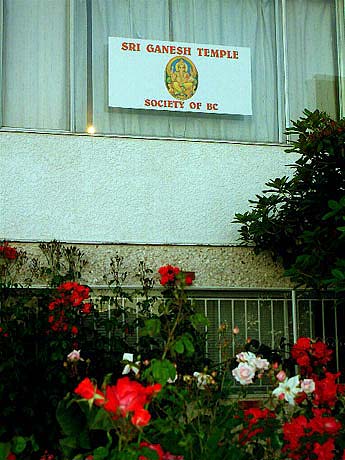
Canadian gardens were bursting with colors and fragrences! The Sri Ganesha temple’s rose garden was overflowing with roses. This photo captures but a few of the dozens of rose bushes in full bloom.
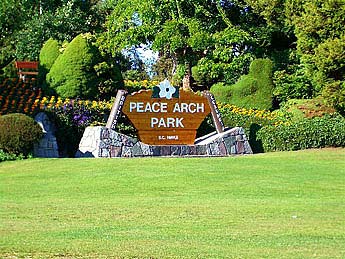
If you travel by auto to one of the many Vancouver, Canada, temples the Peace Arch Park will welcome you to Canada.

The Murugan Temple on River Road, Richmond, B.C. Bodhinatha was hosted here by a small but dynamic group.
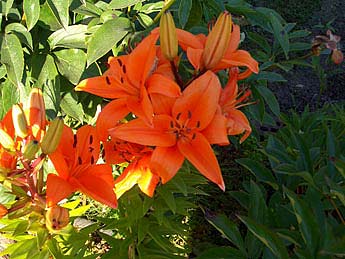
Colorful flowers for Lord Muruga.

Bodhinatha and devotees at the Murugan temple. We were not allowed to photograph Lord Muruga, but He was resplendent in sandalwood.
Today’s Aadheenam Guests

Usha Satish arrived with her relatives, two very lovely families who are visiting for five days. Satish Krishnamurthy, a neurosurgeon and his daughter Akhila from Syracuse, N.Y. His brother Shekhar Krishnamurthy also came with his wife, Lakshmi and their two children, Sangeeta and Pranav from St. Louis, Mo. After worshiping in the Kadavul Siva Temple, they toured the grounds of the Aadheenam and visited the Iraivan Temple.
Here they posed for a group family photo in front of the Sanctum of the Iraivan Temple.
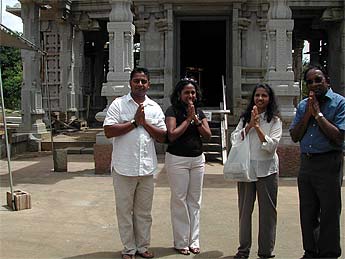
Another family joined us there. Maha Caldera and his wife from West Covina, California, and their daughter Neluka and her husband, Sanjay DeSilva from Sacramento, California. Neluka and Sanjay were married just yesterday on Kauai. Here they are at the Iraivan Temple building site.
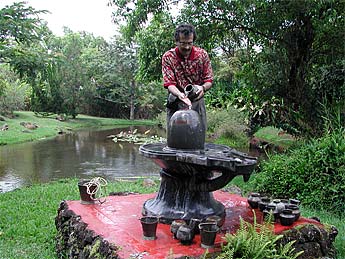
After visiting the path of the Saiva Saints, which encircles the lotus ponds, everyone performed Abishekam to the sacred Narmada Lingam.


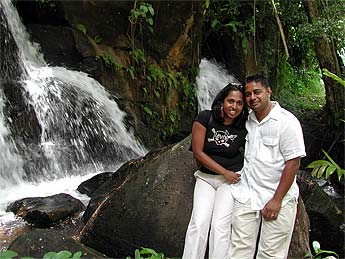
A side trip was then made to the waterfalls where the newly-weds Sanjay and Neluka posed for a final photo.
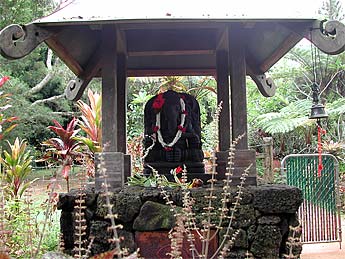
The lovely, simple but powerful image of Lord Ganesha that sits at the beginning of Tiruneri path up to Kadavul is called “Napali Ganesha.”

Carved in Nepalese style, He’s know for dispensing visions and grace to pilgrims.
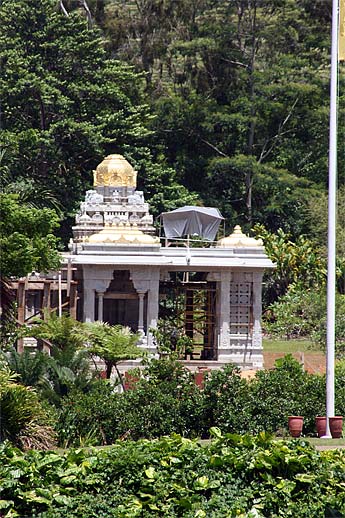
The tropical setting for Iraivan Temple never fails to amaze visitors.
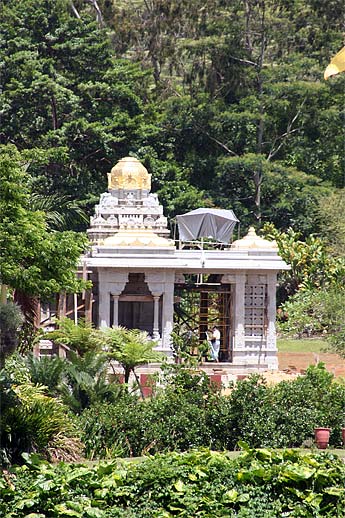
Iraivan is one of many beautiful temples, but one of a very-few-in-this-world such temples in such a paradiasical setting.
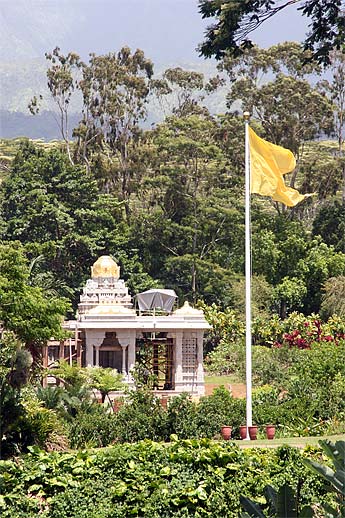
While many lovely temples are being built around the world by devout Hindus, it is understandably common for them to be near a highway, surrounded by asphalt parking places.
Or not far from a factory or even in the midst of a bustling city.
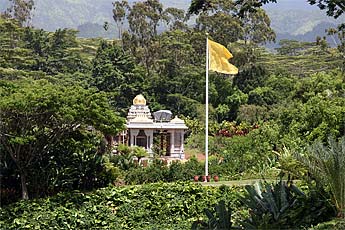
Visitors look out in disbelief, for it seems they have stumbled on an ancient temple in an uninhabited jungle, surrounded only by nature, and nature at Her finest.
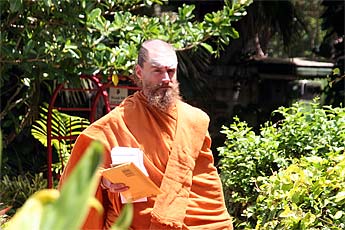
Saravananathaswami and Satya are working in the Ekadanta Kulam on major outreach projects today. Swami is taking the morning’s correspondence to the mail room.
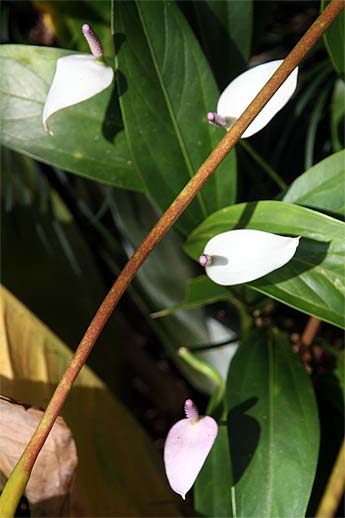
En route he passes a petite anthurium reacing for the sun from a shaded niche.
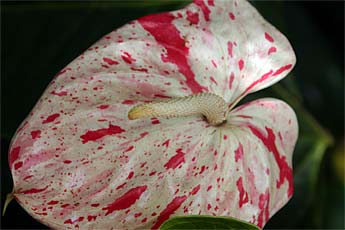
Nearby the famed Peppermint anthurium, specled with Siva white and Shakti red. Or did someone spill paint on it?
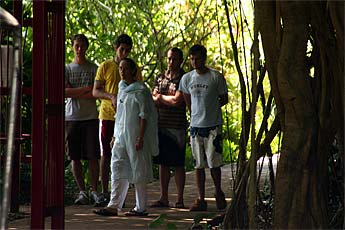
Isani guides visitors through the giant banyan entry.
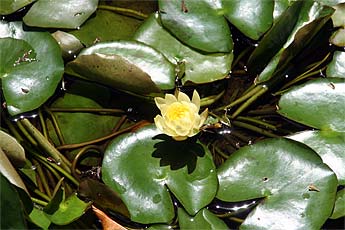
A dwarf water lily takes a peek at the summer sun.
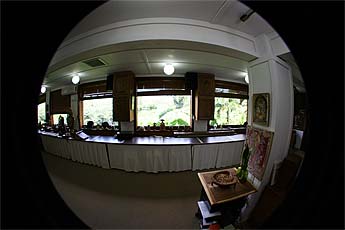
In the publications world, we look out of the window from Palaniswami’s desk.
Giant Parampara Batik Arrives
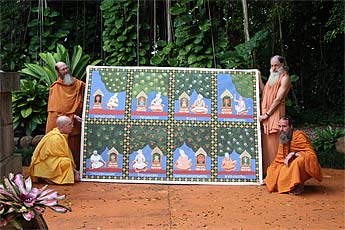
Today we received this marvelous 5.5-foot by 8.5-foot cloth batik from India. It took the artist three full months to paint this work of art. It was our goal to have it in time for Guru Purnima, which is just 9 days away!

This batik depicts our Guru Paramparai, from Nandinatha to Bodhinatha. Each of the gurus is worshipping a different form of Siva in a small shrine, and above each is a different sacred flower or fruit. The batik will hang behind the Swayambhu Lingam on July 9th, and Bodhinatha will be seated in front of it for the grand annual Pada Puja that morning.
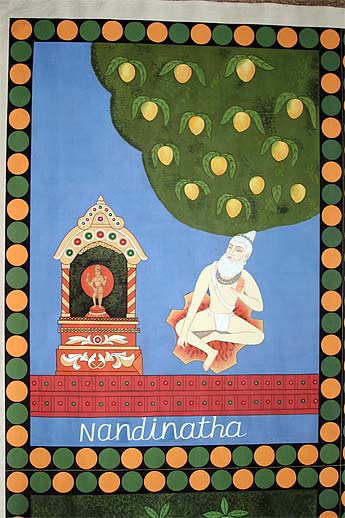
This is Satguru Nandinatha, first in our lineage, who lived high in the Himalayas 2,200 years ago. These were luminous beings, engulfed in the Clear White Light day and night. Who can hide such radiance for long? People still came. The most ardent drew near, and the teachings were passed from one to the next over the centuries. Not in classes or seminars. In the old way, by word of mouth, by the preceptor testing the disciple, preparing the disciple, guiding the disciple in daily context and in dreams. Such men can shake the seeker’s mind loose from its shackles, arouse awareness from the slumber of so many births and turn questions like “Who am I?” into proclamations of “I am That.” All this the gurus of the Yogaswami lineage did. In today’s TAKA we give a glimpse of these great souls and the God-centered nondualism they taught.
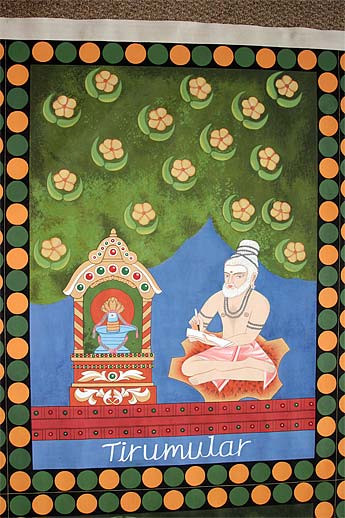
Nandinatha initiated Tirumular and directed him to bring pure Saiva Siddhanta to the South of India. Tirumular walked the length of India and settled at Tiruvavadhurai in Tamil Nadu, writing the great philosophical epic, Tirumantiram, in the Tamil language. It is a summary of the agamas and the great yogas, and remains one of the greatest spiritual works of all time.
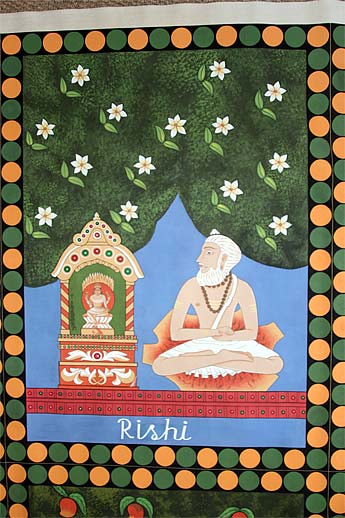
One afternoon sometime in the mid-1800s a whitehaired man happened into a tea shop near Bangalore in South-Central India. He was a stranger, probably from the Himalayan crown of India. He sat at a wooden table and took his tea. When the time came for the shop to close, the owner found that the man had entered a state of contemplation so complete that he could not be aroused. Besides, it is considered improper to disturb a meditator. So he was left alone. Opening the shop early the next day, the shopkeeper discovered the yogi seated in perfect stillness, filling the room with a palpable sanctity. He did not move from that spot for seven years, nor did he speak. The shop closed. Villagers turned it into a shrine frequented by the crowds who wanted darshana, or sight, of this remarkable being. Many came with problems, the kind people everywhere have a new job, grandmother’s health, daughter’s marriage. To their amazement, answers always came. Sometimes in dreams. Sometimes a piece of paper would materialize in the air above the saint and float gently to the ground. On it would be written exactly what they needed. One day, as suddenly as he had come, the Rishi emerged from his divine state, got up and left the shop, never to return. He was the first modern-day satguru in our lineage and is known as the Rishi from the Himalayas.
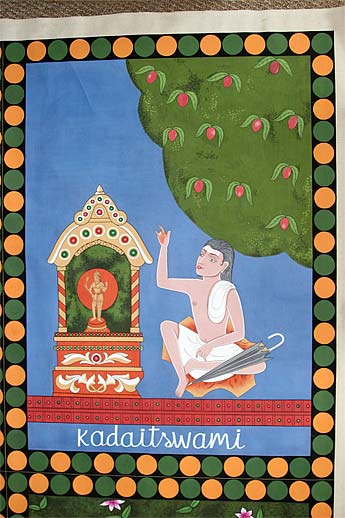
A few years later, farther south, a high court judge sat at the end of a trial, faced with the duty to pass a sentence of death on a convicted murderer. The man was guilty, but the judge refused to fatally condemn a fellow human being. Instead, he left the bench, quit the law and renounced the world. He became a wandering monk. In time he met the Rishi and was initiated into the inner teachings. Eventually he settled in Sri Lanka’s port city of Jaffna. It was around 1860. He had no home, no ashrama or yoga school. He could be found walking in the marketplace, speaking of man’s oneness with God Siva and taking his meals with common folks. The people called him Kadaitswami, the “Marketplace Swami. One day Kadaitswami was invited for lunch at the home of a devout but poor family. With little food in the house and not wanting to off end a great soul, the wife did the unthinkable–she sold her cherished gold wedding neck lace to buy provisions. When the meal was finished, the swami asked her to bring a piece of iron. A rusty old rod was found. Kadaitswami took it aside, spat on it and handed it back. It had turned to gold! Today this is a wealthy coconut oil family, though it is said they never sold the golden rod.

The next satguru in this tradition was called Chellappaswami (1840–1945). Chellappan means wealthy father. Except in a spiritual sense, he was anything but rich. In fact, most thought him a vagrant, and mad in the bargain. He wore disheveled clothing and preferred to be alone. At age nineteen, Chellappan was initiated by Kadaitswami. Thereafter he camped on the steps of Jaffna’s Nallur Temple, that is when he was not walking the country roads, which he did frequently and energetically. Chellappaswami spoke of God only in the first person, oblivious of duality, never admitting that there was –another. He would puzzle passersby by asking questions like –Did you know that I am the King of kings? –Did anyone tell you that all the money in all the banks in the world is mine? Chellappaswami was strict with himself, especially about food. He cooked his own meals, simple affairs of boiled rice and dal. His favorite curry was eggplant, for which he would sometimes walk ten miles to the market to get fresh and ten miles back. Never would he allow base desire to well up. If it did, if his mouth would so much as water at the smell of a hard-earned curry, he would chide himself, –So, you want this tasty food that much, do you? Laughing aloud he would pick up the clay cooking pots and break them on the ground. Then he would meditate on greater things as the crows loudly shared the scattered food. One morning a pilgrim was walking by the temple where Chellappaswami lived. Suddenly, the sage laughed, calling out, “Just who do you think you are?” It was a seemingly innocuous query, but somehow it went deep into the heart, then deeper and deeper. Later the 35-year-old man left all worldly life and joined Chellappan as his disciple.
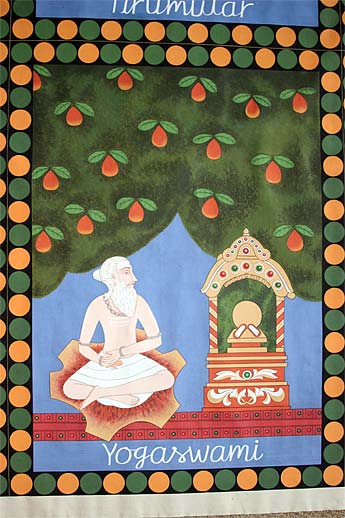
This was Sage Yogaswami (1872–1964), who wrote many verses recounting that meeting: I saw my guru at Nallur Temple. “Hey! Who are you?” he challenged me. I saw darkness all-surrounding and could not comprehend his meaning. As I stood perplexed, he looked at me with kindness, and the maya that was tormenting me left and disappeared. He pointed above my head, and I lost all consciousness of body and stood there in amazement. He then spoke of the essence of Vedanta, that my fear might vanish. “It is as it is. Who knows? Grasp well the meaning of these words,” said he. Everything disappeared and by the grace of my guru, who has no one to compare with him, I remained still, with no one to compare with me. Thus Yogaswami wrote of how he was captured by his satguru.
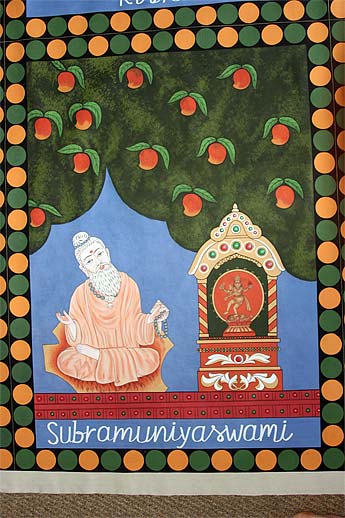
In 1947 a 20-year-old American sailed from San Francisco to Bombay in search of his guru. His cabin on the ship was directly over the engine room. It was his habit to meditate long hours each day in his room. One morning his contemplation was particularly deep, and as he returned to normal consciousness the mechanical roar of the engines became annoying, then grating, then unbearable. In his mind he spontaneously commanded the noise to –Stop! The engines immediately halted, and the ship drifted quietly and inexplicably for two days before the voyage was resumed. Arriving in India at age 21, the youth traveled south by train. Crossing the straits to Sri Lanka, he found himself among Buddhist and Hindu mystics. His urge to realize God fully grew irresistibly intense. Entering the dense jungles southeast of Colombo, he settled in the famed Caves of Jalani, vowing to fast and meditate until he attained the ultimate illumination. A mystic from a nearby mosque observed the young man disciplining himself and growing thinner as he med itated longer and longer. One day the mystic was amazed to see a giant snake slither across the lap of the yogi, who had lost body consciousness. Finally, the youth broke through the various wheels of consciousness, or chakras, into full enlightenment, beyond time, beyond form, beyond space. Months later, the youth was taken to Sage Yogaswami” s humble hut in the North. The 77-year-old Yogaswami named him Subramuniya, –silent teacher of light, and initiated him in to the famed mantra Nama Sivaya. Later, on the full-moon day in May, 1949, his satguru initiated him into the holy orders of sannyasa and, with a forceful slap on the back, commanded him to carry the ancient Natha teachings back to the West. The event was acclaimed a coronation by all who witnessed. Sage Yogaswami attained oneness in 1964, and Sivaya Subramuniya swami continued the lineage, founding temples in the West and building Kauai Aadheenam in Hawaii in 1970. Gurudeva was deeply immersed in furthering the global Hindu renaissance for half a century. He reached Siva” s feet on November 12, 2001.
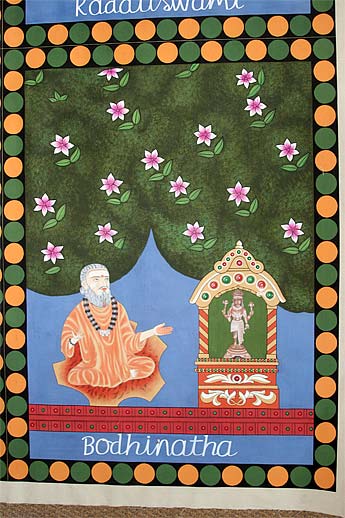
Before departing this world, he ordained Bodhinatha Veylanswami, his senior disciple for 37 years, as his immediate successor, who today carries forth the mission of teaching the Saivite Hindu path to enlightenment, a path that leads the soul from simple service to worshipful devotion to God, from the disciplines of meditation and yoga to the direct knowing of Divinity within. Today Bodhinatha is in Canada visiting temples and communities of seekers, carrying forth the eternal work of the Kailasa Paramparai as did those before.
From Our Gurus' Teachings
Archives are now available through 2001. Light colored days have no posts. 1998-2001 coming later.
